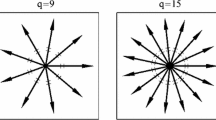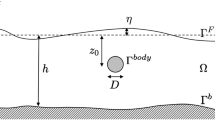Abstract
A meshfree weak-form method based on combining a radial point interpolation method (RPIM) and modified Dirichlet-to-Neumann (MDtN) boundary condition is proposed for use in analyzing underwater acoustic radiation. To apply a meshfree weak-form method to exterior acoustic radiation prediction, an unbounded problem domain is truncated by an artificial boundary to yield a finite computational domain. To improve the interpolation accuracy, RPIM is used to form an acoustic shape function without use of a mesh or connectivity of nodes to implement field variable interpolations. An MDtN boundary condition is imposed on the artificial boundary to guarantee a unique solution. The factors affecting the performance of the devised method are investigated, and numerical examples are used to test its performance. Simulations indicate that the method can produce more accurate results and converge faster and more efficiently, and is less sensitive to the acoustic wavenumber than the finite element scheme. Therefore, this proposed method is competitive at predicting underwater acoustic radiation.



























Similar content being viewed by others
References
Ciskowski RD, Brebbia CA (2005) Boundary element methods in acoustics. Kluwer Academic Publishers Group, The Netherlands
Kirkup S (2007) The boundary element method in acoustics. Integrated Sound Software
Liu XJ, Wu HJ, Jiang WK (2017) Hybrid approximation hierarchical boundary element methods for acoustic problems. J Comput Acoust 25(3):1750013
Marburg S (2016) The burton and miller method: Unlocking another mystery of its coupling parameter. J Comput Acoust 24(1):1550016
Marburg S (2018) A pollution effect in the boundary element method for acoustic problems. J Theor Comp Acout 26:1850018
Wu YH, Dong CY, Yang HS, Sun FL (2021) Isogeometric symmetric FE-BE coupling method for acoustic-structural interaction. Appl Math Comput 393:125758
Takahashi T, Yamamoto T, Shimba Y, Isakari H, Matsumoto T (2019) A framework of shape optimisation based on the isogeometric boundary element method toward designing thin-silicon photovoltaic devices. Eng Comput 35:423–449
Gong JY, An JY, Ma L, Xu HT (2017) Numerical quadrature for singular and near-singular integrals of boundary element method and its applications in large-scale acoustic problems. Chin J Acoust 36:289–301
Kirkup S (2019) The boundary element method in acoustics: a survey. Appl Sci 9(8):1642
Ihlenburg F (1998) Finite element analysis of acoustic scattering. Springer, New York
Kaltenbacher M (2018) Computational acoustics. Springer, Berlin
Servan-Camas B, Gutierrez-Romero JE, Garcia-Espinosa J (2018) A time-domain second-order FEM model for the wave diffraction-radiation problem. Validation with a semisubmersible platform. Mar Struct 58:278–300
He ZH, Chen ZH, Jiang YB, Cao XF, Zhao T (2020) Effects of the standoff distance on hull structure damage subjected to near-field underwater explosion. Mar Struct 74:102839
Thompson LL (2006) A review of finite-element methods for time-harmonic acoustics. J Acoust Soc Am 119(3):1315–1330
Zienkiewicz O, Bando K, Bettess P, Chiam T (1985) Mapped infinite elements for exterior wave problems. Int J Numer Meth Eng 21:1229–1251
Hu X, Cui XY, Zhang QY, Wang G, Li GY (2017) The stable node-based smoothed finite element method for analyzing acoustic radiation problems. Eng Anal Bound Elem 80:142–151
Xu XY, Zhang GY, Zhou B, Wang HY, Tang Q (2019) Analysis of acoustic radiation problems using the cell-based smoothed radial point interpolation method with Dirichlet-to-Neumann boundary condition. Eng Anal Bound Elem 108:447–458
Dai TF, Jin X, Yang HZ, Lin TR, Gu YT (2020) Smoothed finite element methods for predicting the mid to high frequency acoustic response in the cylinder-head chamber of a diesel engine. Int J Comp Meth 17(9):1950060
Liu GR, Zhang GY (2013) Smoothed point interpolation methods: G space theory and weakened weak forms. World Scientific, Singapore
Chai YB, Li W, Gong ZX, Li TY (2016) Hybrid smoothed finite element method for two-dimensional under water acoustic scattering problems. Ocean Eng 116(1):129–141
Liu GR, Zhang GY, Zong Z, Li M (2013) Meshfree cell-based smoothed alpha radial point interpolation method (CS-\(\alpha\) RPIM) for solid mechanics problems. Int J Comp Meth 10(4):1350020
Li W, Chai YB, Lei M, Li TY (2017) Numerical investigation of the edge-based gradient smoothing technique for exterior Helmholtz equation in two dimensions. Comput Struct 182(1):149–164
Chai YB, Li W, Li TY, Gong ZX, You XY (2016) Analysis of underwater acoustic scattering problems using stable node-based smoothed finite element method. Eng Anal Bound Elem 72:27–41
Chai YB, Li W, Liu GR, Gong ZX, Li TY (2017) A superconvergent alpha finite element method (S\(\alpha\)FEM) for static and free vibration analysis of shell structures. Comput Struct 179(15):27–47
Keller J, Givoli D (1989) Exact non-reflecting boundary conditions. J Comput Phys 82(1):172–192
Givoli D, Patlashenko I (1998) Optimal local non-reflecting boundary conditions. Appl Numer Math 27:3670384
Grote M, Keller J (1995) On nonreflecting boundary conditions. J Comput Phys 122:231–243
Hsiao G, Nigam N, Pasciak J, Xu L (2011) Error analysis of the DtN-FEM for the scattering problem in acoustics via fourier analysis. J Comput Appl Math 235:4949–4965
Geng HR, Yin T, Xu LW (2017) A priori error estimates of the DtN-FEM for the transmission problem in acoustics. J Comput Appl Math 313:1–17
Oberai AA, Malhotra M, Pinsky PM (1998) On the implementation of the DtN radiation condition for iterative solution of the Helmholtz equation. Appl Numer Math 27:443–464
Li PJ, Yuan XK (2020) Convergence of an adaptive finite element DtN method for the elastic wave scattering by periodic structures. Comput Method Appl M 360:112722
Koyama D (2009) Error estimates of the finite element method for the exterior Helmholtz problem with a modified DtN boundary condition. J Comput Appl Math 232:109–121
Grote MJ, Kirsch C (2004) Dirichlet-to-Neumann boundary conditions for multiple scattering problems. J Comput Phys 201:630–650
Ofir Y, Givoli D (2015) DtN-based mixed-dimensional coupling using a Boundary Stress Recovery technique. Comput Method Appl M 287:31–53
Liu GR, Gu YT (2005) An introduction to meshfree methods and their programming. Springer Verlag, The Netherlands
Abbasbandy S, Ghehsareh HR, Hashim I (2012) Numerical analysis of a mathematical model for capillary formation in tumor angiogenesis using a meshfree method based on the radial basis function. Eng Anal Bound Elem 36(12):1811–1818
Dehghan M, Shokri A (2008) A numerical method for solution of the two dimensional sine-Gordon equation using the radial basis functions. Math Comput Simul 79(3):700–715
Belytschko T, Lu YY, Gu L (1994) Element-free Galerkin methods. Int J Numer Methods Eng 37(2):229–256
Zhang Z, Hao SY, Liew KM, Cheng YM (2013) The improved element-free Galerkin method for two-dimensional elastodynamics problems. Eng Anal Bound Elem 37(12):1576–1584
Liu GR, Wu YL, Ding H (2004) Meshfree weak-strong (MWS) form method and its application to incompressible flow problems. Int J Numer Meth Fl 46(10):1025–1047
Gu YT, Liu GR (2005) A meshfree weak-strong (MWS) form method for time dependent problems. Compt Mech 35(2):134–145
Tian X, Lin J (2020) A novel radial basis function method for 3D linear and nonlinear advection diffusion reaction equations with variable coefficients. Eng Comput https://doi.org/10.1007/s00366-020-01161-1
Dehghan M, Shafieeabyaneh N (2021) Local radial basis function-finite-difference method to simulate some models in the nonlinear wave phenomena: regularized long-wave and extended Fisher-Kolmogorov equations. Eng Comput 37:1159–1179
Hashemi MS (2020) Numerical study of the one-dimensional coupled nonlinear sine-Gordon equations by a novel geometric meshless method. Eng Comput https://doi.org/10.1007/s00366-020-01001-2
Oruç \(\ddot{\rm O}\) (2021) An efficient meshfree method based on Pascal polynomials and multiple-scale approach for numerical solution of 2-D and 3-D second order elliptic interface problems. J Comput Phys 428:110070
Oruç \(\ddot{\rm O}\) (2019) Numerical solution to the deflection of thin plates using the two-dimensional Berger equation with a meshless method based on multiple-scale Pascal polynomials. Appl Math Model 74:441–456
Oruç \(\ddot{\rm O}\) (2020) A local hybrid kernel meshless method for numerical solutions of two-dimensional fractional cable equation in neuronal dynamics. Numer Meth Part D E 36(6):1699–1717
Oruç \(\ddot{\rm O}\) (2022) A strong-form local meshless approach based on radial basis function-finite difference (RBF-FD) method for solving multi-dimensional coupled damped Schrödinger system appearing in Bose-Einstein condensates. Commun Nonlinear Sci 104:106042
Liu GR, Gu YT (2001) A point interpolation method for two-dimensional solids. Int J Numer Meth Eng 50(4):937–951
Liu GR, Gu YT (2003) A matrix triangularization algorithm for the polynomial point interpolation method. Comput Method Appl M 192(19):2269–2295
Liu GR, Gu YT (2001) A local radial point interpolation method (LR-PIM) for free vibration analyses of 2-D solids. J Sound Vib 246(1):29–46
Wang JG, Liu GR (2002) A point interpolation meshless method based on radial basis functions. Int J Numer Meth Eng 54(11):1623–1648
Oruç \(\ddot{\rm O}\) (2020) Two meshless methods based on local radial basis function and barycentric rational interpolation for solving 2D viscoelastic wave equation. Comput Math Appl 79:3272–3288
Oruç \(\ddot{\rm O}\) (2021) A local radial basis function-finite difference (RBF-FD) method for solving 1D and 2D coupled Schrödinger-Boussinesq (SBq) equations. Eng Anal Bound Elem 129:55–66
Liu GR, Dai KY, Lim KM, Gu YT (2003) A radial point interpolation method for simulation of two-dimensional piezoelectric structures. Smart Mater Struct 12(2):171–180
Liu L, Liu GR, Tan VBC (2002) Element free method for static and free vibration analysis of spatial thin shell structures. Comput Method Appl M 191(51–52):5923–5942
Wang JG, Liu GR, Lin P (2002) Numerical analysis of Biot’s consolidation process by radial point interpolation method. Int J Solids Struct 39(6):1557–1573
Atluri S, Zhu T (1998) A new Meshless Local Petrov-Galerkin (MLPG) approach in computational mechanics. Comput Mech 22:117–127
Liu GR, Gu YT (2001) A local point interpolation method for stress analysis of two-dimensional solids. Struct Eng Mech 11:221–236
Liu GR, Yan L, Wang JG, Gu YT (2002) Point interpolation method based on local residual formulation using radial basis functions. Struct Eng Mech 14:713–732
Oliveira T, Vélez W, Santana W, Araújo T, Mendonça F, Portela A (2019) A local mesh free method for linear elasticity and fracture mechanics. Eng Anal Bound Elem 101:221–242
Santana E, Oliveira T, Vélez W, Araújo A, Martins F, Portela A (2020) A local mesh free numerical method with automatic parameter optimization. Eng Anal Bound Elem 113:55–71
Liu GR, Gu YT (2004) Boundary meshfree methods based on the boundary point interpolation methods. Eng Anal Bound Elem 28(5):475–487
Araújo A, Martins F, Vélez W, Portela A (2021) Automatic mesh-free boundary analysis: multi-objective optimization. Eng Anal Bound Elem 125:264–279
Wenterodt C, Estorff OV (2011) Optimized meshfree methods for acoustics. Comput Method Appl M 200(25):2223–2236
Zhang GY, Chen ZC, Sui ZX, Tao DS (2019) A cell-based smoothed radial point interpolation method with virtual nodes for three-dimensional mid-frequency acoustic problems. Int J Numer Methods Eng 119(6):548–566
Wu SW, Xiang Y, Yao JC (2018) A meshfree radial point interpolation coupled with infinite acoustic wave envelope element method for computing acoustic fields. Acta Acust United Ac 104:64–78
Qi LB, Wu YS, Zou MS, Yu Y (2019) Propeller-shaft-hull coupled vibration and its impact on acoustic radiation utilizing sono-elasticity theory. Ocean Eng 171:391–398
Qi LB, Zou MS, Liu SX, Yu Y (2019) Use of impedance mismatch in the control of coupled acoustic radiation of the submarine induced by propeller-shaft system. Mar Struct 65:249–258
Acknowledgements
This work was supported by the National Natural Science Foundation of China (Grant No. 51909016), the Natural Science Foundation of Chongqing, China (Grant No. cstc2020jcyj-msxmX0070), the Science and Technology Research Program of Chongqing Municipal Education Commission (Grant No. KJZD-K202100702 and KJQN201900705) and the Key Laboratory of Marine Power Engineering & Technology (Wuhan University of Technology), Ministry of Transport (Grant No. KLMPET2019-04).
Author information
Authors and Affiliations
Corresponding author
Ethics declarations
Conflict of interest
The authors declare that they have no known competing financial interests or personal relationships that could have appeared to influence the work reported in this paper.
Additional information
Publisher's Note
Springer Nature remains neutral with regard to jurisdictional claims in published maps and institutional affiliations.
Rights and permissions
About this article
Cite this article
Wu, S., Xiang, Y. & Li, G. A coupled weak-form meshfree method for underwater noise prediction. Engineering with Computers 38, 5091–5109 (2022). https://doi.org/10.1007/s00366-021-01593-3
Received:
Accepted:
Published:
Issue Date:
DOI: https://doi.org/10.1007/s00366-021-01593-3




